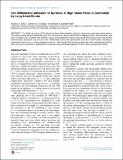Von Willlebrand Adhesion to Surfaces at High Shear Rates Is Controlled by Long-Lived Bonds
Author(s)
Sing, Charles E.; Selvidge, Jennifer G.; Alexander-Katz, Alfredo; Selvidge, Jennifer G.
DownloadAlexander-Katz_Von Willlebrand.pdf (662.2Kb)
PUBLISHER_POLICY
Publisher Policy
Article is made available in accordance with the publisher's policy and may be subject to US copyright law. Please refer to the publisher's site for terms of use.
Terms of use
Metadata
Show full item recordAbstract
Von Willebrand factor (vWF) adsorbs and immobilizes platelets at sites of injury under high-shear-rate conditions. It has been recently demonstrated that single vWF molecules only adsorb significantly to collagen above a threshold shear, and here we explain such counterintuitive behavior using a coarse-grained simulation and a phenomenological theory. We find that shear-induced adsorption only occurs if the vWF-surface bonds are slip-resistant such that force-induced unbinding is suppressed, which occurs in many biological bonds (i.e., catch bonds). Our results quantitatively match experimental observations and may be important to understand the activation and mechanical regulation of vWF activity during blood clotting.
Date issued
2013-08Department
Massachusetts Institute of Technology. Department of Materials Science and EngineeringJournal
Biophysical Journal
Publisher
Elsevier
Citation
Sing, Charles E., Jennifer G. Selvidge, and Alfredo Alexander-Katz. “Von Willlebrand Adhesion to Surfaces at High Shear Rates Is Controlled by Long-Lived Bonds.” Biophysical Journal 105.6 (2013): 1475–1481.
Version: Author's final manuscript
ISSN
00063495
1542-0086